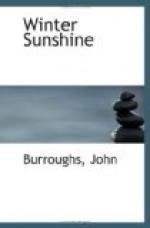How rich in color, before the big show of the tree foliage has commenced, our roadsides are in places in early autumn,—rich to the eye that goes hurriedly by and does not look too closely,—with the profusion of goldenrod and blue and purple asters dashed in upon here and there with the crimson leaves of the dwarf sumac; and at intervals, rising out of the fence corner or crowning a ledge of rocks, the dark green of the cedar with the still fire of the woodbine at its heart. I wonder if the waysides of other lands present any analogous spectacles at this season.
Then, when the maples have burst out into color, showing like great bonfires along the hills, there is indeed a feast for the eye. A maple before your windows in October, when the sun shines upon it, will make up for a good deal of the light it has excluded; it fills the room with a soft goldenglow.
Thoreau, I believe, was the first to remark upon the individuality of trees of the same species with respect to their foliage,—some maples ripening their leaves early and some late, and some being of one tint and some of another; and, moreover, that each tree held to the same characteristics, year after year. There is, indeed, as great a variety among the maples as among the trees of an apple orchard; some are harvest apples, some are fall apples, and some are winter apples, each with a tint of its own. Those late ripeners are the winter varieties,—the Rhode Island greenings or swaars of their kind. The red maple is the early astrachan. Then come the red-streak, the yellow-sweet, and others. There are windfalls among them, too, as among the apples, and one side or hemisphere of the leaf is usually brighter than the other.
The ash has been less noticed for its autumnal foliage than it deserves. The richest shades of plum-color to be seen—becoming by and by, or in certain lights, a deep maroon—are afforded by this tree. Then at a distance there seems to be a sort of bloom on it, as upon the grape or plum. Amid a grove of yellow maple, it makes a most pleasing contrast.
By mid-October, most of the Rip Van Winkles among our brute creatures have lain down for their winter nap. The toads and turtles have buried themselves in the earth. The woodchuck is in his hibernaculum, the skunk in his, the mole in his; and the black bear has his selected, and will go in when the snow comes. He does not like the looks of his big tracks in the snow. They publish his goings and comings too plainly. The coon retires about the same time. The provident wood-mice and the chipmunk are laying by a winter supply of nuts or grain, the former usually in decayed trees, the latter in the ground. I have observed that any unusual disturbance in the woods, near where the chipmunk has his den, will cause him to shift his quarters. One October, for many successive days, I saw one carrying into his hole buckwheat which he had stolen from a near field. The hole




